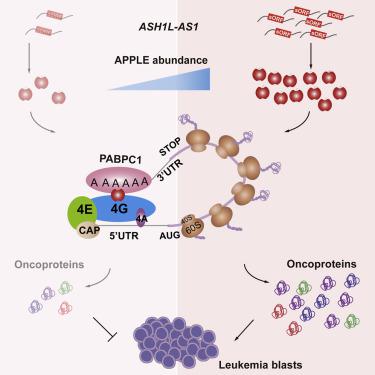Molecular Cell ( IF 16.0 ) Pub Date : 2021-09-22 , DOI: 10.1016/j.molcel.2021.08.033 Linyu Sun 1 , Wentao Wang 1 , Cai Han 1 , Wei Huang 1 , Yumeng Sun 1 , Ke Fang 1 , Zhancheng Zeng 1 , Qianqian Yang 1 , Qi Pan 1 , Tianqi Chen 1 , Xuequn Luo 2 , Yueqin Chen 1

|
Initiation is the rate-limiting step in translation, and its dysregulation is vital for carcinogenesis, including hematopoietic malignancy. Thus, discovery of novel translation initiation regulators may provide promising therapeutic targets. Here, combining Ribo-seq, mass spectrometry, and RNA-seq datasets, we discovered an oncomicropeptide, APPLE (a peptide located in ER), encoded by a non-coding RNA transcript in acute myeloid leukemia (AML). APPLE is overexpressed in various subtypes of AML and confers a poor prognosis. The micropeptide is enriched in ribosomes and regulates the initiation step to enhance translation and to maintain high rates of oncoprotein synthesis. Mechanically, APPLE promotes PABPC1-eIF4G interaction and facilitates mRNA circularization and eIF4F initiation complex assembly to support a specific pro-cancer translation program. Targeting APPLE exhibited broad anti-cancer effects in vitro and in vivo. This study not only reports a previously unknown function of micropeptides but also provides new opportunities for targeting the translation machinery in cancer cells.
中文翻译:

肿瘤微肽 APPLE 通过增强翻译起始促进造血系统恶性肿瘤
起始是翻译中的限速步骤,其失调对致癌作用至关重要,包括造血系统恶性肿瘤。因此,发现新的翻译起始调节剂可能会提供有希望的治疗靶点。在这里,结合 Ribo-seq、质谱和 RNA-seq 数据集,我们发现了一种肿瘤微肽 APPLE(位于 ER 中的肽),由急性髓性白血病 (AML) 中的非编码 RNA 转录物编码。APPLE 在各种 AML 亚型中过度表达,预后不良。微肽富含核糖体并调节起始步骤以增强翻译并维持癌蛋白的高合成率。机械地,APPLE 促进 PABPC1-eIF4G 相互作用并促进 mRNA 环化和 eIF4F 起始复合物组装,以支持特定的促癌翻译程序。靶向苹果表现出广泛的抗癌作用体外和体内。这项研究不仅报告了以前未知的微肽功能,而且为靶向癌细胞中的翻译机制提供了新的机会。



























 京公网安备 11010802027423号
京公网安备 11010802027423号